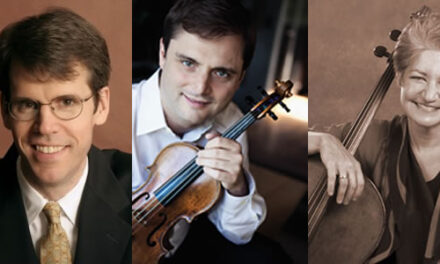The Haen Gallery at 200 King Street in Brevard is enjoying a new life. At one time the space was home to the Brevard Lumber Co., but in recent years it’s been reclaimed as a spacious venue for the visual arts and the occasional concert. The renovations have not been overdone; one can clearly see the bare bones of the building and feel the original utilitarian purpose of the space. Fortunately, all the exposed hard surfaces make possible some delightful acoustics, especially when artists such as those of Pan Harmonia are attuned to its sonic properties. The musicians in this inaugural concert of Pan Harmonia’s 15th season were Artistic Director Kate Steinbeck, flutes; Fred Lemmons, clarinets and bass clarinet; and Amy Brucksch, guitar. The program will be repeated on September 8 at the “sister” Haen Gallery in Asheville (for details of which, see the sidebar).
After a prelude of wine and cheese, the concert opened with “Entr’acte” (1935) by Jacques Ibert, for flute and guitar. This melodious work, though short, was a perfect vehicle for Steinbeck’s soaring expressiveness. The work featured many fluctuations of intensity and swirling melodic figures, each of which received a finely nuanced interpretation. The strumming insistency of Brucksch’s guitar, coupled with the many passages played with rubato, called to mind the colorful Basque region neighboring Ibert’s native France.
“Watertown Dance,” Op. 75, by Massachusetts native Tom G. Febonio (b.1950) brought together a trio of alto flute, bass clarinet, and guitar. Beginning with a contemplative Adagio, the piece morphed into a funky Allegro, certainly a connection to the composer’s early performance experiences as a rock musician. The music was suave and sensual, and a great crowd pleaser.
Steinbeck performed solo “Be Still My Soul” (2003) by Rhonda Larson (b.1962), a free fantasy on Jean Sibelius’ original hymn tune. Though the original music was indeed “still” and serene, this highly emotional adaptation arced and swirled throughout the flute’s registers in a dazzling display.
Less successful was Lemmons’s performance of the Allemande, Courante, and Gigue from Bach’s Cello Suite No. 4, S.1010, on bass clarinet. While this was somewhat of a novelty number, obviously the writing was not idiomatic to the instrument (certainly a wind instrument). Amid the thicket of notes played at breakneck speed (especially the gigue), I simply could not discern either clear phrasing or the unique character of each dance.
Next was the Sonata for Flute and Clarinet from the mid 1940’s by Argentinian composer Alberto Ginastera, transcribed from the original work for flute and oboe by Daniel Dorff for A clarinet and flute. This engaging three movement work showcased the duo’s tight ensemble work, with fugato elements in the two outer movements, and a lovely inner Pastorale which, with its perfectly blended timbres, was one of the concert’s highlights.
Brucksch next performed solo the “Sons de Carrilhões” (Sounds of the Bells), a work in the style of the “choro” by Brazilian composer João Pernambuco. Derived from a style of street music in Brazil, the work was gently swaying with a catchy rhythm and sing-able melodies which Brucksch executed beautifully.
Two jazz-inspired works utilized different ensembles. “Luminescence” (1998) by Dana Wilson (b.1946), for alto flute and guitar, is one of this duo’s “smoky” jazz favorites; in fact, it is the title track to their CD by that name. “Aurora” (2007) by British composer Mark Houghton (b.1959), received here its North Carolina premiere. Composed for flute, clarinet, and guitar, its syncopated jazz rhythms and arching lyricism were perfectly suited for this ensemble and was another highlight of the evening.
To close, the ensemble performed the four-movement Flute Sonata in F Major by George Frideric Handel. The roles of basso continuo were played by Brucksch with Lemmons on bass clarinet, a colorful combination which worked well, with the exception of the two legato slow movements, in which the clarinet slightly overpowered the guitar (the latter was amplified for the entire concert). That said, the overall effect was delightful in every way.
For an encore, the trio switched to B-flat clarinet, guitar, and flute for a ravishingly beautiful rendition of “Musetta’s Waltz” (“Quando men vo”) from Puccini’s La Bohème, literally sending us on our way with this incomparable song in our hearts.












